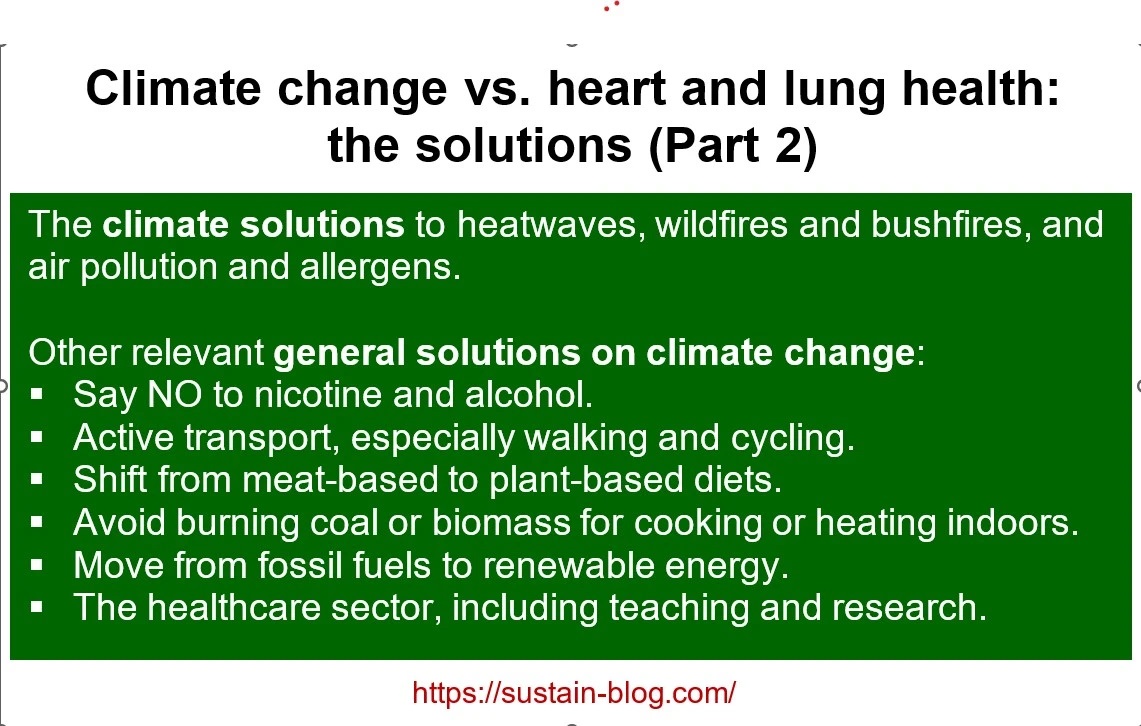Climate change vs. heart and lung health: the solutions (Part 2)

How does climate change affect the health of our heart and lungs?
In the previous post, titled Climate change vs. heart and lung health: the causes and effects (Part 1), we looked at the causes of climate change and how it effects the health of our heart and lungs.
The health of our heart and lungs is affected by heatwaves, wildfires and bushfires, air pollution and allergens, and other extreme weather events, including flooding.
In this post (i.e., part 2), we look at how do we ensure that our heart and lungs stay healthy in the event of climate change?
The solutions to ensure the health of our heart and lungs
Acting with better understanding of the effects of climate change is important for the health of our heart and lungs. The solutions to these three problems of climate change are as follows.
Heatwaves
In a heatwave, staying hydrated is a priority. So, drink plenty of water. If you have heart failure, follow your doctor’s advice on how much you should drink water each day. If possible, avoid alcohol, too much caffeine and the drinks high in sugar. These can make you more dehydrated.
Keep cool by staying indoors. Since electric fans use a lot less electricity than air conditioning, use an electric fan. Cool yourself and other in the family while using less electricity and saving you money.
Take a cold shower or sponge yourself with cool water to keep your skin wet. Keep your clothing wet by spraying yourself with cool water roughly every hour. Put your feet or your hands and forearms in a bucket of cool water. When outdoors, stick to the shade as much as possible. Wear loose, light-coloured clothing. Reduce your level of physical activity when it is hot.
Plan if you know a heatwave is coming. This might include doing your shopping ahead of time or making sure you have enough of your medicines. Being prepared means you can limit the amount of time you have to spend outside when the weather is hot.
If you take medicines for a heart condition, your doctor might need to adjust them. This includes some medicine for blood pressure. Certain medicines can also increase the risk of dehydration. Keep your medicines stored in a cool, dry place below 25C or, if it is allowed, in the fridge.
Know the symptoms of heat-related illness, such as muscle pain or cramps, dizziness, strong thirst, headache, fainting, feeling tired or weak, nausea or vomiting and confusion.
Keep in contact with your family and friends. Let them know if you are okay or if you need help. Check on people who are isolated or might need help, especially if they have a heart condition or other chronic condition like diabetes.
Wildfires and bushfires
In a wildfire or a bushfire, drink water, use an electric fan indoors and take care of the medicine as if you are facing a heatwave.
If it is safe to do so, stay indoors. Keep your windows and doors shut when there is smoke outside. Open them when the smoke disappears. It you had to leave the premises, find cleaner, air-conditioned spaces, such as a shopping centres, a school or a library.
Limit outdoor physical activity (including walking) if you are in a smoke or fire-affected area, especially if the air quality is very poor or hazardous. Aim to exercise during parts of the day when air quality is better. Keep up to date with advice from your local government on what to do.
Consider staying with family members or friends if they live outside the smoke-affected area.
Air pollution and allergens
Know the air quality in your area. If you know when air pollution levels are high, you can take steps to limit your exposure.
If you have a heart or a lung condition, avoid spending a long time in places that have higher air pollution levels, such as busy roads or near factories.
Where possible, walk or cycle in places where air pollution is lower. Or choose a time of day when air pollution levels are lower (for example, before or after peak hour). Use the car sparingly.
Avoid indoor fires for cooking and warmth. If this is not possible, portable air purifiers can help reduce indoor air pollution.
Other general solutions on climate change
In general, the solutions for a healthy heart and lungs are as follows.
Nicotine is bad. If you love your heart or lungs, stop smoking. Stop, or minimise drinking alcohol. Drink plenty of water.
Shift to active transport, such as walking and cycling. It would not only help to promote physical activity but also reduce greenhouse gas emissions.
Red meat, which contains high levels of saturated fat, is an established risk factor for heart disease. A transition from predominantly meat-based to plant-based diets is good, facilitated by a restructuring of food subsidies.
Burning coal or biomass for cooking or heating indoors releases greenhouse gases and was responsible for over 1 million cardiovascular deaths in 2019. So, providing clean cooking stoves is a cost-effective way of improving global cardiovascular and respiratory health, while cutting emissions.
An expansion of green spaces in residential areas will help to reduce stress and soak up atmospheric CO2. A shift away from fossil fuels (e.g., coal, oil, and gas) towards renewable energy (e.g., solar and wind power, geothermal energy, and hydroelectricity) is ideal. Such transition would save more than 20 million attributable deaths over the next 30 years.
Healthcare systems can reduce their carbon footprint by promoting telemedicine, local ambulatory care, and self-care, and by cutting down on overtreatment, overprescribing, and unnecessary interventions. They should also invest in disaster planning and early warning systems to prepare for waves of illness associated with climate change. Medical education should incorporate teaching and research on environmental health and sustainable practices in healthcare. The healthcare sector must take urgent action to prevent the climate crisis from undermining cardiovascular and respiratory health.
In general, to maintain the health of our heart and lungs, reduce climate change.


